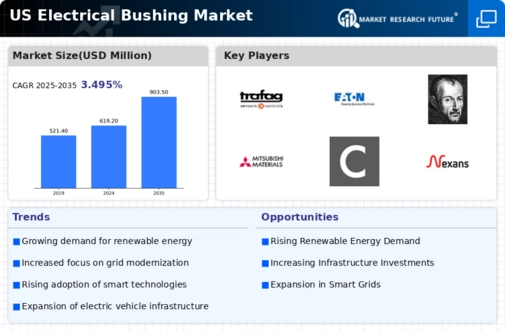Rising Demand for Renewable Energy
The increasing focus on renewable energy sources in the US is driving the electrical bushing market. As more wind and solar power plants are constructed, the need for reliable electrical components, including bushings, becomes paramount. In 2025, the renewable energy sector is projected to account for approximately 30% of the total energy generation in the US. This shift necessitates the use of high-quality electrical bushings to ensure efficient energy transmission and distribution. Furthermore, the integration of renewable energy into existing grids requires specialized bushings that can handle varying loads and conditions, thereby enhancing the overall reliability of the electrical bushing market.
Increased Focus on Energy Efficiency
The US government's commitment to enhancing energy efficiency is influencing the electrical bushing market. Policies aimed at reducing energy consumption and promoting sustainable practices are leading to the adoption of advanced electrical components. In 2025, energy efficiency programs are expected to save consumers approximately $30 billion annually. This trend encourages manufacturers to develop innovative electrical bushings that minimize energy losses during transmission. As energy efficiency becomes a priority for both consumers and businesses, the demand for high-performance electrical bushings is likely to rise, further propelling the market forward.
Infrastructure Upgrades and Modernization
The ongoing upgrades and modernization of aging electrical infrastructure in the US significantly impact the electrical bushing market. Many utilities are investing heavily in replacing outdated equipment to improve efficiency and reliability. In 2025, it is estimated that over $100 billion will be allocated for infrastructure improvements across the country. This investment includes the replacement of old transformers and substations, which often require new electrical bushings. As utilities strive to meet increasing energy demands and regulatory standards, the electrical bushing market is likely to experience substantial growth driven by these infrastructure initiatives.
Regulatory Compliance and Safety Standards
The stringent regulatory compliance and safety standards in the US are driving advancements in the electrical bushing market. Utilities and manufacturers are required to adhere to various safety regulations, which necessitate the use of high-quality electrical components. In 2025, it is anticipated that compliance costs will rise, prompting companies to invest in superior electrical bushings that meet or exceed these standards. This focus on safety not only protects consumers but also enhances the reliability of electrical systems. Consequently, the electrical bushing market is likely to benefit from increased demand for products that align with regulatory requirements.
Expansion of Electric Vehicle Infrastructure
The rapid expansion of electric vehicle (EV) infrastructure in the US is creating new opportunities for the electrical bushing market. As the number of EV charging stations increases, the demand for reliable electrical components, including bushings, is expected to grow. By 2025, the US is projected to have over 1 million public charging stations, necessitating robust electrical systems to support this infrastructure. The integration of electrical bushings in charging stations ensures safe and efficient power distribution, thereby enhancing the overall performance of the EV network. This trend indicates a promising future for the electrical bushing market as it adapts to the evolving landscape of transportation.





















Leave a Comment